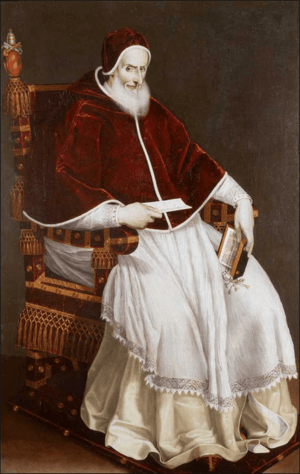Regnans in Excelsis facts for kids
Regnans in Excelsis means "Reigning on High" in Latin. It was a special letter, called a papal bull, sent by Pope Pius V on February 25, 1570. This bull officially excommunicated (removed from the Catholic Church) Queen Elizabeth I of England. The Pope called her "the pretended Queen of England and the servant of crime."
The bull said Queen Elizabeth was a heretic (someone who goes against official Church teachings). It also told her subjects (the people of England) that they no longer had to be loyal to her. This included people who had sworn oaths to her. The bull even said that anyone who obeyed Elizabeth's orders would also be excommunicated.
The Pope listed several reasons for his decision. He said Elizabeth had removed Catholic nobles from her royal council. She replaced them with people who were Protestant. The bull also claimed she had treated Catholic followers badly. It stated she brought in new, non-Catholic preachers and stopped traditional Catholic practices. These included the Mass, prayers, fasting, and celibacy for priests. The Pope also said she ordered books with non-Catholic ideas to be spread. She also made her subjects follow new religious rules, similar to those of John Calvin.
The bull is named after its first three words in Latin, which is common for papal documents.
Contents
Why the Pope Issued the Bull
Before Elizabeth, Queen Mary I had brought England back to the Catholic Church. But after Mary died in 1558, Elizabeth became queen. In 1559, her Parliament passed the Act of Supremacy. This law made the Church of England independent from the Pope's power again.
The Pope's bull was a strong reaction to this change. However, it was issued 11 years later. This delay happened partly because some Catholic princes hoped to marry Elizabeth. Also, she had allowed Catholics to practice their faith in private for a while.
What the Bull Said
Pope Pius V issued Regnans in Excelsis after some Catholic uprisings against Elizabeth. These included the failed Rising of the North in 1569. In this event, Catholic nobles tried to remove Elizabeth and replace her with Mary, Queen of Scots. There was also the first Desmond Rebellion in Ireland. This rebellion started in June 1569. While it was mainly about local lords keeping their power, it gained religious meaning. James FitzMaurice FitzGerald sought support from Catholic countries in Europe.
The bull clearly stated that Queen Elizabeth was excommunicated. It freed her subjects from any loyalty they owed her. It also said that anyone who followed her orders would be excommunicated too. The Pope believed he had the power to remove rulers from their thrones if they went against the Church.
Pope Pius V did not ask for advice from other Catholic rulers. Both Philip II of Spain and Emperor Maximilian II disagreed with his plan. Philip thought the bull would only make Elizabeth treat English Catholics more harshly. This turned out to be true. The bull gave Elizabeth's government a reason to persecute Catholics.
To make the bull official, it had to be announced publicly. People like John Felton helped spread the news.
What Happened Next
The bull made the English government take stronger actions against Catholics. They especially targeted Jesuits. The government worried that Jesuits were working for Spain and the Pope.
This fear seemed justified in 1571. The bull's publication in England helped spark the Ridolfi plot. In this plot, the Duke of Norfolk planned to kidnap or murder Queen Elizabeth. The goal was to put Mary, Queen of Scots on the throne. Then, the Duke hoped to marry Mary and become the real ruler.
A scholar from Zurich, Heinrich Bullinger, wrote a criticism of the bull in 1571.
Temporary Change to the Bull (1580-1584)
To help Catholics in England, Pope Gregory XIII made a change to the bull in 1580. He said that Catholics should obey Queen Elizabeth in everyday matters. This was allowed until a good chance came to overthrow her. It's not clear how many Catholics in England and Ireland knew about this change.
Later that same year, Pope Gregory supported an attempt to help the Second Desmond Rebellion in Ireland. This effort failed at the Siege of Smerwick. Soon after the Anglo-Spanish War (1585–1604) began, England passed a law against Jesuits and Catholic priests.
The Bull is Reissued (1588)
In 1588, Pope Sixtus V supported the Spanish Armada's planned invasion of England. He reissued the bull of excommunication against Queen Elizabeth I. This was partly because Elizabeth had ordered the execution of Mary, Queen of Scots, in 1587. It also included the earlier reasons against the Catholic Church.
However, during the threat of the Spanish Armada, most English Catholics remained loyal to Elizabeth. Those who were a real threat, like Cardinal William Allen and Robert Persons, were already living in exile.
The bull had little effect in England. But it caused problems in Elizabeth's Kingdom of Ireland. Most people there were still Catholic. Gerald FitzGerald, 14th Earl of Desmond, used the bull to justify the Second Desmond Rebellion. Before 1570, there were already divisions. After the bull, officials in Dublin followed the Anglican Church. However, most members of the Parliament of Ireland remained Catholic until 1613.
See also
- John Felton (martyr)
- Religion in the United Kingdom
- Cuius regio, eius religio



